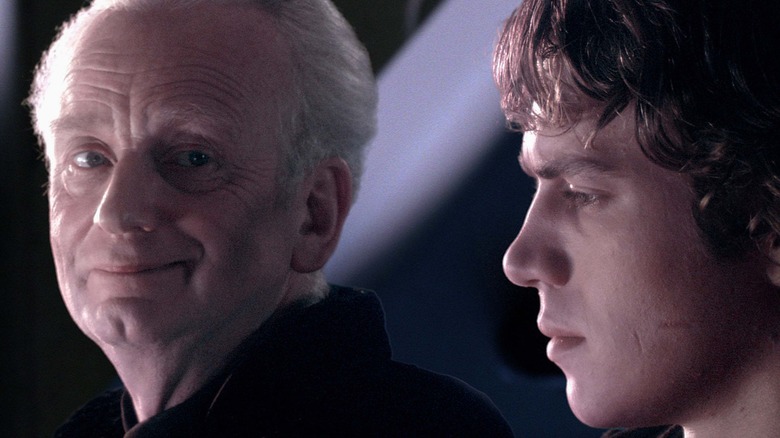How Exactly Do The Sith 'Cloud' The Jedi With The Force In Star Wars?
From a certain point of view, Sheev Palpatine is the true main character of the "Star Wars" prequel trilogy. He has a clear goal — unmitigated dominion over the galaxy and the genocide of the Jedi by his hand — and he works tirelessly in the shadows to make it happen. He succeeds for many reasons, including his raw Force power and his penchant for delegating, but perhaps the most important tool he employs is the ability to mask his true nature from the Jedi surrounding him on Coruscant.
In the old "Star Wars" Expanded Universe, now known in the Disney era as the Legends timeline, this technique was referred to as "Force clouding," with variations bearing names like Force stealth, or Force concealment. The ability is explored in detail in texts like the "Darth Bane" book series (which explains how the Sith "Rule of Two" came to be) and James Luceno's 2012 "Darth Plagueis" novel. The latter story leads right up to and even overlaps with "The Phantom Menace," so the Force clouding technique is particularly relevant given Sheev's ascension to Supreme Chancellor of the Republic.
In the current canon, there is no formal explanation for how Palpatine manages to cloud the Jedi's future sight and keep himself hidden. It's more a general understanding that his dark side mastery allows him to conceal his true nature in the Force, which in turn obfuscates the Jedi Council's ability to predict what will come. How this power actually manifests is still up for some discussion.
How Force clouding works in Star Wars Legends
The essence of Force clouding, as it's explained in the Legends timeline, is that it's more of a constant act of concentration than a spell you cast (except sometimes — we'll get to that). Jedi are able to feel other life forms and energies through the Force, as everything is connected. The Sith technique was basically a projection, putting forward an energy signature that blended in with the background noise and masked the dark side energy of the Sith in question. Doing this over an extended length of time required both substantial power and delicate focus. The fact that Palpatine successfully maintains the charade for so many years is even more impressive.
In "Darth Bane: Rule of Two," a deeper form of Force clouding is introduced, by which a Sith could project not just a neutral image, but one of light side power. This technique, hiding the user as a Jedi, required a more in-depth use of arcane Sith magic.
The transformation that Palpatine undergoes in "Revenge of the Sith" is likely due in part to the release of this spell. He can finally stop masking his true form and focus the full brunt of his energy outward. This doesn't explain how he's able to prevent the Jedi from seeing the future, though.
How does Palpatine cloud the Jedi's vision?
A running theme throughout the prequels is that the Jedi can no longer see the future clearly. While their foresight was never perfect, it's significantly diminished in the years directly preceding Order 66. Yoda and other members of the council can still get vague shapes of things at times, but nothing concrete.
There are multiple explanations for why this is, and the ultimate truth is really a combination of them. In the Legends timeline, we know that Sith, like Darth Bane and, later, Darth Plagueis and Darth Sidious, conducted extensive experiments with dark side sorcery, all in the effort of concealing their grand plan of conquering the galaxy. While many of these plots are no longer canon, it's safe to assume that Palpatine is doing his fair share of meddling.
Another piece of the puzzle is that the Jedi Temple is actually built atop an ancient dark side shrine. This storyline, originally introduced in Legends and brought back in several canon texts since, suggests that there may have been a gradual buildup of dark Force energy around the Jedi Council for centuries without their knowledge. Such corruption may have contributed to their flawed vision, giving the Sith the opportunity they needed.
Lastly, it's generally understood in "Star Wars" that as darkness grows, light fades, and vice versa. The mechanics of the "Rule of Two" are more vague in canon than they were in the old Expanded Universe, but the core principle holds true: If you only have one person holding all the power, and another seeking it ruthlessly, you may achieve greater strength than you would be distributing it. By the prequels, the Jedi have become corrupted by dogmatic beliefs, and the Sith have hoarded immense strength.


